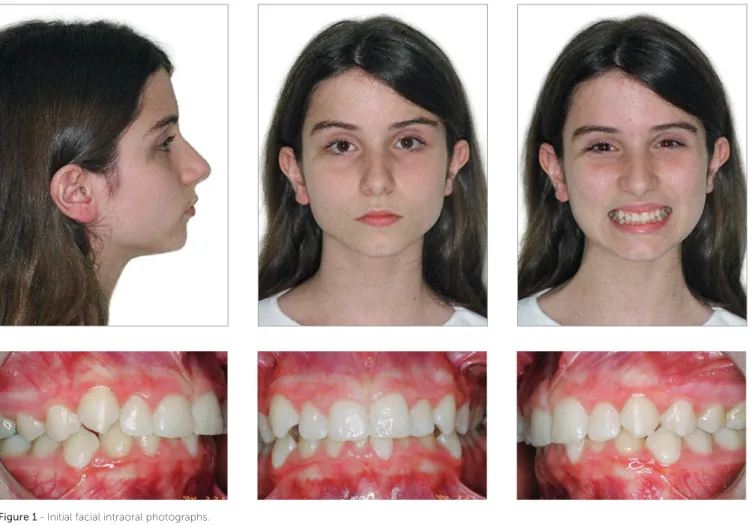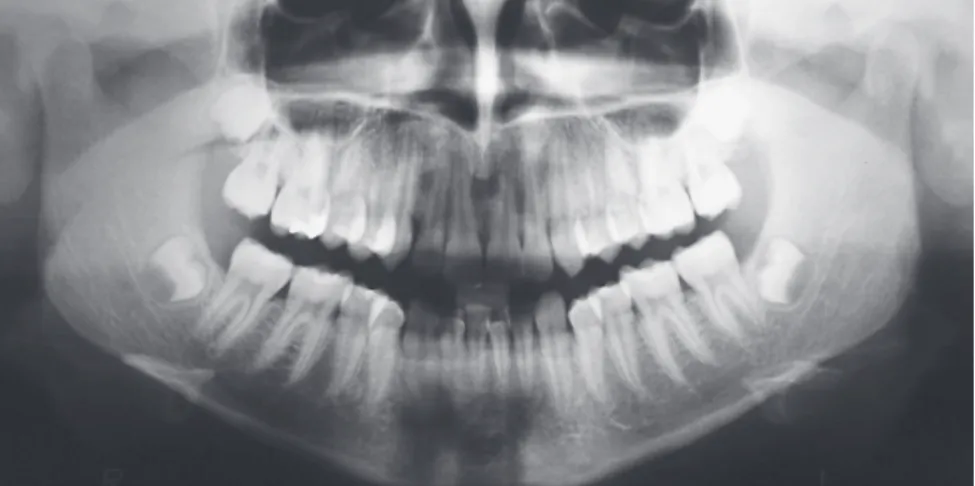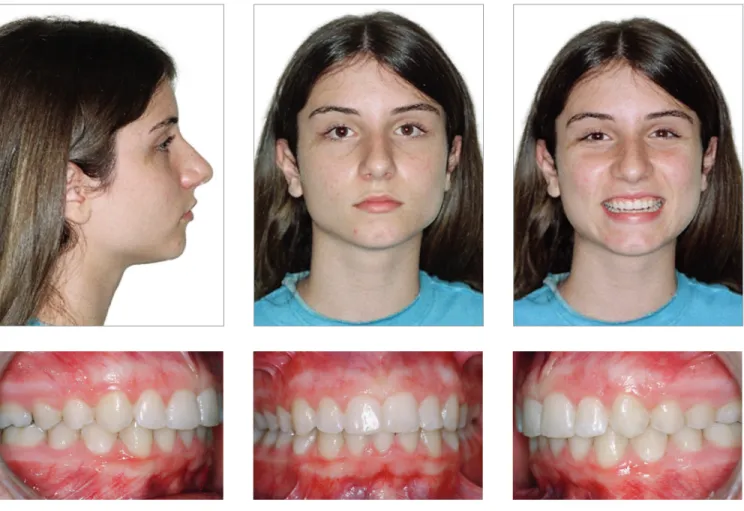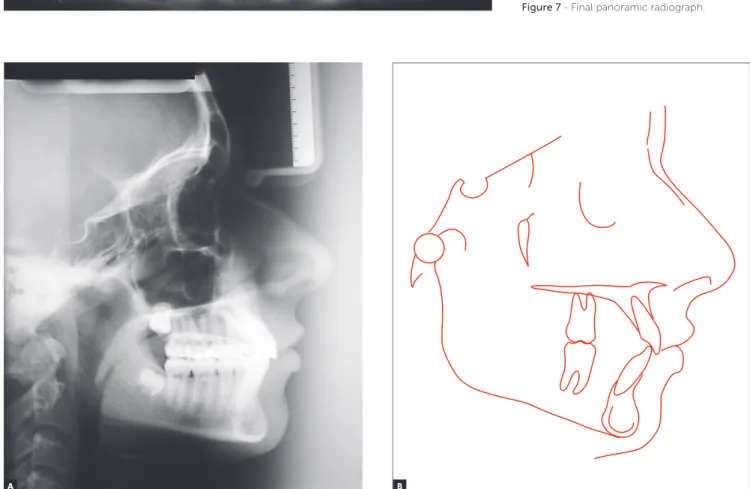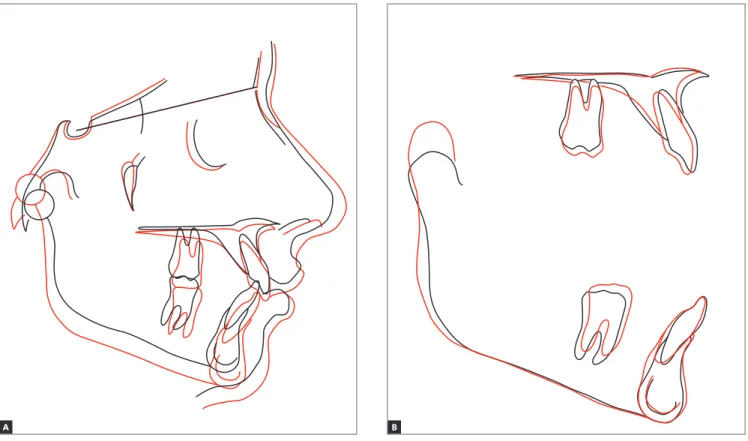Treating dental crowding with mandibular incisor
extraction in an Angle Class I patient
Gislana Braga Machado1
How to cite this article: Machado GB. Treating dental crowding with man-dibular incisor extraction in an Angle Class I patient. Dental Press J Orthod. 2015 May-June;20(3):101-8.
DOI: http://dx.doi.org/10.1590/2176-9451.20.3.101-108.bbo
Submitted: March 16, 2015 - Revised and accepted: March 24, 2015
» Patient displayed in this article previously approved the use of her facial and intraoral photographs.
Contact address: Gislana Braga Machado
Av. 7 de Setembro, 4698, Conj. 1707, Batel, CEP: 80240-000, Curitiba, Paraná, Brazil. E-mail: gislanabm@hotmail.com » The author reports no commercial, proprietary or financial interest in the
prod-ucts or companies described in this article.
1 Specialist in Orthodontics, Universidade de São Paulo (USP), Bauru, São
Paulo, Brazil. Specialist in Temporomandibular Disorders and Orofacial Pain, Conselho Federal de Odontologia (CFO). Diplomate of the Brazilian Board of Orthodontics (BBO).
* Case report, approved by the Brazilian Board of Orthodontics and Dentofacial
Orthopedics (BBO).
INTRODUCTION
The present study reports the case of a Caucasian female patient who sought orthodontic treatment at the age of 12 years and 5 months, with good gen-eral health and chief complaint of mandibular dental
crowding. Her medical records were not signiicant, while her dental records revealed trauma with a mi-nor fracture on the incisal edge of her right maxillary central incisor.
Mandibular dental crowding often encourages patients to seek orthodontic treatment. The orthodontist should decide between protrusion of incisors or decrease in dental volume so as to achieve proper alignment and leveling. The present study reports the treatment of an Angle Class I malocclusion adolescent female brachyfacial patient with severe mandibu-lar dental crowding, increased curve of Spee and deep overbite. The patient was treated with extraction of a mandibumandibu-lar incisor. This case was presented to the Brazilian Board of Orthodontics and Dentofacial Orthopedics (BBO) as a require-ment for the title of certified by the BBO.
Keywords:Angle Class I malocclusion. Tooth extraction. Incisor.
DOI: http://dx.doi.org/10.1590/2176-9451.20.3.101-108.bbo
O apinhamento dentário inferior, com frequência, motiva os pacientes a buscarem tratamento ortodôntico. Ao ortodon-tista cabe a decisão entre protruir os incisivos ou diminuir o volume dentário, a fim de obter o adequado alinhamento e nivelamento. O presente relato aborda o tratamento de uma má oclusão Classe I de Angle, em paciente adolescente, sexo feminino, braquifacial, com severo apinhamento na arcada inferior, curva de Spee e sobremordida aumentadas, e tratada com exodontia de um incisivo inferior. Esse caso clínico foi apresentado à Diretoria do Board Brasileiro de Ortodontia e Ortopedia Facial (BBO) como parte dos requisitos para a obtenção do título de Diplomado pelo BBO.
Figure 1 - Initial facial intraoral photographs.
Figure 3 - Initial panoramic radiograph.
Figure 4 - Initial lateral cephalogram (A) and cephalometric tracing (B).
A B
DIAGNOSIS
Frontal-view facial analysis revealed balanced fa-cial thirds and slightly everted lower lip. Lateral-view analysis revealed a convex profile, mild mandibular deficiency and mild bimaxillary lip protrusion (Fig 1). From a dental perspective, the patient was classified as Angle Class I, with 3.5-mm overbite, 1-mm over-jet, increased curve of Spee, 3.5-mm upper crowding
and 7-mm lower crowding (Figs 1, 2). Panoramic radiograph revealed the presence of all teeth with root integrity (Fig 3). Cephalometrically (Fig 4 and Table 1), the patient had a Class II skeletal brachyfa-cial pattern, with mandibular deficiency (SNA = 78o;
SNB = 73.5o; ANB = 4.5o), well-positioned maxillary
incisors and tipped as well as protruded mandibular
hindering lip seal and stability. For this reason, the pos-sibility of locally solving the problem with extraction of a mandibular incisor was considered, despite being aware that overjet could not be incresed.1 To this end,
it was important to avoid excess tipping of maxillary in-cisors, increase the crown of the remaining mandibular central incisor and wait for anterior mandibular protru-sion to happen as a result of growth.
Based on this proposal, treatment plan was de-veloped with a view to keeping the Class I molar and canine relationship, adapting lateral and pro-trusive guidances, aligning maxillary teeth so as to avoid increase in protrusion, aligning and leveling mandibular teeth so as to correct the curve of Spee and reduce overbite, and keeping protrusion and tipping of mandibular incisors unchanged so as to preserve passive lip seal. To this end, the use of fixed orthodontic appliance was chosen, without includ-ing maxillary incisors until there was enough space to position the canines as a result of interproximal stripping in the posterior segment (from mesial sur-faces of second premolars to distal sursur-faces of ca-nines). Treatment planning also included the use of a palatal bar with a Nance holding arch for upper anchorage; extraction of tooth #31 due to gingival recession; and increase in crown height of tooth #41 (0.5 mm distally and mesially).
After the end of conventional treatment, plan-ning included the use of an upper Hawley retainer 24 hours a day during 12 months and during the night
0.022 x 0.028-in slot, Straight Wire) in both arches. Mandibular second molars were also included at this stage, differently from maxillary incisors which would be included after canines were properly in place.
The sequence of proximal stripping began with first and second premolars as well as maxillary ca-nines, at high speed, after the interproximal areas of these teeth were separated with the aid of elastic sepa-rators. Distalization of first premolars and canines was carried out with elastomeric modules. During the phase of maxillary alignment, there was a need for proximal stripping between teeth #11/21 and 21/22. Alignment and leveling began with NiTi 0.12-in wires up to stainless steel 0.020-in wires. Mandibular archwires were kept by the tie-back method so as to control arch circumference. Maxillary and mandibu-lar rectangumandibu-lar XR archwires were placed before rectan-gular stainless steel continuous 0.019 x 0.025-in arch-wires. After crown-root angulation of tooth #41, the patient was referred to have crown height increased with 0.5-mm resin placed on each proximal surface. Treatment finishing included Class II intermaxillary mechanics with elastics and stainless steel 0.018-in continuous archwires for intercuspation.
Figure 5 - Final facial intraoral photographs.
Figure 7 - Final panoramic radiograph.
Figure 8 - Final lateral cephalogram (A) and cephalometric tracing (B).
Figure 9 - Total (A) and partial (B) cephalometric superimpositions of initial (black) and final (red) cephalometric tracings. B
A
Table 2 - Measurements of transversal distances of initial (A) and final (B) dental arches. Table 1 - Initial (A) and final (B) cephalometric values.
Measurements Normal A B Dif. A/B
Skeletal pattern
SNA (Steiner) 82° 78° 77° 1
SNB (Steiner) 80° 73.5° 73.5° 0
ANB (Steiner) 2° 4.5° 3.5° 1
Angle of convexity (Downs) 0° 8° 5° 3
Y axis (Downs) 59° 64° 59° 5
Facial angle (Downs) 87° 80.5° 87° 6.5
SN-GoGn (Steiner) 32° 35° 33.5° 1.5
FMA (Tweed) 25° 28.5° 21° 7.5
Dental pattern
IMPA (Tweed) 90° 101° 107° 6
1.NA (degrees) (Steiner) 22° 22° 23° 1
1-NA (mm) (Steiner) 4 mm 5 mm 5 mm 0
1.NB (degrees) (Steiner) 25° 30° 33° 3
1-NB (mm) (Steiner) 4 mm 7 mm 6 mm 1
1
1- Interincisal angle (Downs) 130° 123.5o 121o 2.5
1-APo (Ricketts) 1 mm 3 mm 2 mm 1
Profile Maxillary lip — S-line (Steiner) 0 mm 1 mm -1 mm 2
Mandibular lip — S-line (Steiner) 0 mm 3.5 mm 0 mm 3.5
Measure A B Dif. A/B
Maxillary intercanine width 34.3 mm 33.8 mm 0.5
1. Konstantonis D, Anthopoulou C, Makou M. Extraction decision and identiication of treatment predictors in Class I malocclusions. Prog Orthod. 2013;14:47.
2. Livas C, Jongsma AC, Ren Y. Enamel reduction techniques in
orthodontics: a literature review. Open Dent J. 2013;7:146-51.
3. Raju DS, Veereshi AS, Naidu DL, Raju BH, Goel M, Maheshwari A.
Therapeutic extraction of lower incisor for orthodontic treatment. J Contemp Dent Pract. 2012;13(4):574-7.
4. Harati M, Mostoi SN, Jalalian E, Rezvani G. Smile line and occlusion: An epidemiological study. Dent Res J. 2013;10(6):723-7.
5. Germec D, Taner TU. Efects of extraction and nonextraction therapy
with air-rotor stripping on facial esthetics in postadolescent borderline patients. Am J Orthod Dentofacial Orthop. 2008;133(4):539-49. 6. Leonardi R, Annunziata A, Licciardello V, Barbato E. Soft tissue changes
following the extraction of premolars in nongrowing patients with bimaxillary protrusion: a systematic review. Angle Orthod. 2010;80(1):211-6. 7. Barbosa VL. Angle Class I malocclusion treated with lower incisor
extraction. Dental Press J Orthod. 2013;18(3):150-8.
8. Zhylich D, Suri S. Mandibular incisor extraction: a systematic review of an uncommon extraction choice in orthodontic treatment. J Orthod. 2011;38(3):185-95; quiz 231.
9. Brandão RC, Brandão LB. Finishing procedures in Orthodontics: dental
dimensions and proportions (microesthetics). Dental Press J Orthod. 2013;18(5):147-74.
REFERENCES
ping (3o increase in the 1.NB angle and 6o increase in
IMPA), but not in protrusion, with reduction of 1 mm in the linear value of 1.NB angle (Fig 9 and Table 1). Additionally, there was a reduction of 0.5 mm in max-illary intercanine width and 1.2 mm in mandibular in-tercanine width (Table 1).
The end esthetic outcomes were highly satisfacto-ry, with the upper midline coinciding with the facial midline and the long axis of tooth #41 (Figs 5 and 6). Passive lip seal and face as well as smile harmony were also achieved. From a dental perspective, the roots of mandibular incisors were parallel with symmetric spaces in between them (Fig 7).
Partial and total cephalometric superimpositions revealed expressive mandibular growth, although re-duction in the ANB angle only equaled to 1o (Fig 9
and Table 1).
FINAL CONSIDERATIONS
Based on the results of this study, it is reasonable to conclude that extracting patient’s mandibular inci-sor contributed favorably to correct mandibular den-tal crowding which was patient’s chief complaint. The minor change caused to mandibular intercanine width can be considered a factor that contributed to increase long-term alignment stability.1 Even though there was a
potential to increase overjet, this risk was minimized by signiicant mandibular growth forward (Fig 9). Vertical alveolar growth in the region of mandibular molars fa-vored the correction of both curve of Spee and overbite, without the need for incisors intrusion, which enhanced lower incisors exposure and smile esthetics.4 Proile
lat-tening was nonexistent, which could have occurred as a result of premolars extraction.5,6 Mandibular growth
